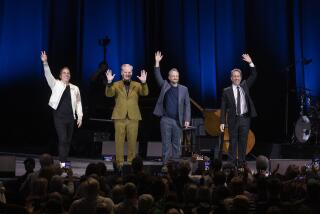Essence of Firesign lost in translation
- Share via
They say that if you remember the ‘60s you weren’t there. But, like everything else about the Firesign Theatre’s batty world, there are exceptions. Over and over again during “Let’s Eat: Feasting on the Firesign Theatre” at Royce Hall Thursday night, I found myself anticipating line after nutty line from old Firesign LPs I hadn’t heard or thought about in decades.
The mind is a funny thing.
Indeed, it is, and it was both senses of funny that Hal Willner, UCLA Live’s artist-in-residence this season, seemed ever so eager to celebrate by gathering actors and musicians to reenact classic Firesign material. Willner is really an artist-artist-in-residence, which is to say he is an artist’s artist -- a producer. His talent is to make connections, ideally off-the-wall as in his brilliant concept album tributes to the likes of Kurt Weill and cartoon composer Carl Stalling.
Firesign Theatre, however, is already so off-the-wall an act that there is real danger in trying to put the walls of a stage around it. This time, for Willner and co-producer Janine Nichols to go against convention was to go with convention. They played Firesign as if it were straight stand-up comedy, pedestrian theater and a loud (loud! loud!! loud!!! loud!!!!) rock concert all rolled into one hopeless package.
The mind is a funny thing -- it reels.
Firesign Theatre was the product of free-form ‘60s radio in L.A. It began with Peter Bergman’s late-night show, “Radio Free Oz,” at the Pacifica station KPFK (90.7 FM), a sonic airport for counterculture. Whatever was in the zeitgeist landed there but without an arrivals schedule. Being even more topsy-turvy than the real world, it sort of grounded a regular listener.
Bergman’s show, with the collaboration of Phil Austin (KPFK’s drama and literature director -- yes, there were such posts in those days), David Ossman and Phil Proctor, eventually morphed into oddball radio comedy with a literate taste for surrealism and a general, all-around irreverence. Columbia Records then gave them a well-equipped studio in which to work, and the rest was history.
Firesign’s talent was to turn any thread of thought into immediate absurdity. Its sense of comic timing was superb. Its ability to mimic the world around it, inspired. But one hates to paraphrase Firesign sketches or characters because their outrageousness -- the skewered car commercials and all the rest -- loses everything in translation. Although the Firesign eventually took its show on the road, its true place was, as a mutant relative of radio, the LP as theater of the mind.
The UCLA show, for which a very good backup band and a cast of 14 actors and singers were assembled, had its moments. Under the right inventive and technically sophisticated circumstance, a wonderful theater piece could be carved from Firesign material. But here nearly everyone, including such seasoned comedians as John Goodman, tried too hard and not nearly hard enough as they read from scripts yet failed to capture characters.
By far the best was Loudon Wainwright III, who did more than anyone else to create a persona, especially of the hippie who buys a fantasy car like no other. Chloe Webb, the only woman in that cast, also managed to enliven her often ditzy roles.
But the essence of Firesign, its creative use of soundscape, was utterly undone by the sound mixer, Eric Liljestrand. He brutally yanked the heart and soul of comedy, theater and imagination out of the material with inapt, inept and perhaps health-threatening amplification. Sometimes it was so astonishingly loud and that words were not understood and sound effects became just uncategorizable sizzling noise.
Not that the audience minded, nor apparently the original Firesign foursome. Never shy for attention, they merrily took to the stage for bows at the end.
More to Read
The biggest entertainment stories
Get our big stories about Hollywood, film, television, music, arts, culture and more right in your inbox as soon as they publish.
You may occasionally receive promotional content from the Los Angeles Times.











